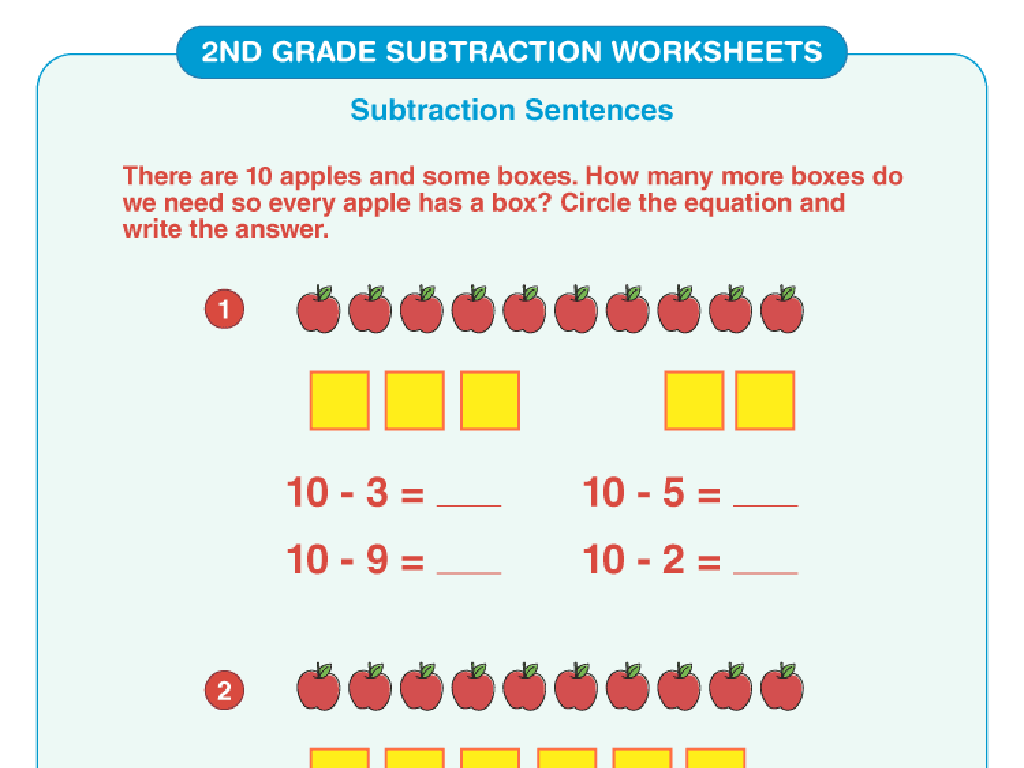Identify Vertebrates And Invertebrates
Subject: Science
Grade: Fifth grade
Topic: Classification
Please LOG IN to download the presentation. Access is available to registered users only.
View More Content
Today’s Adventure: Vertebrates vs. Invertebrates
– Explore the Animal Kingdom
– The vast world of animals with different traits
– Define Classification
– Organizing living things based on their characteristics
– What are Vertebrates?
– Animals with a backbone, like fish, birds, and mammals
– Discover Invertebrates
– Animals without a backbone, such as insects and worms
|
This slide introduces the concept of classification within the Animal Kingdom, distinguishing between vertebrates and invertebrates. Start by discussing the diversity of the animal world and the importance of organizing it into groups. Explain classification as a scientific method used to group animals based on their characteristics. Vertebrates are animals with a spine or backbone, which includes five major groups: mammals, birds, reptiles, amphibians, and fish. Invertebrates, on the other hand, lack a backbone and make up a vast majority of animal species, including insects, arachnids, mollusks, and more. Encourage students to think of examples of each and consider the differences in their physical structures. This foundational knowledge sets the stage for deeper exploration into the characteristics and life processes of these two major animal groups.
Exploring Animal Classification
– What is classification?
– It’s a system to organize living things.
– Basis of animal classification
– Animals are grouped by shared characteristics.
– Vertebrates vs. Invertebrates
– Vertebrates have a spine; invertebrates do not.
– Significance of classification
– Helps us understand animal relationships and evolution.
|
This slide introduces the concept of classification in the animal kingdom, which is a fundamental aspect of biology. Classification helps scientists and students alike to organize and understand the vast diversity of life by grouping animals based on their physical characteristics and genetic relationships. Vertebrates are animals with a backbone, such as fish, birds, and mammals, while invertebrates lack a backbone, including insects, mollusks, and arachnids. Emphasize the importance of classification in studying the relationships between different animal species and their evolutionary history. Encourage students to think of examples of vertebrates and invertebrates they are familiar with and how they might be grouped based on their characteristics.
Meet the Vertebrates
– Vertebrates have backbones
– Examples: Fish, Amphibians, Reptiles, Birds, Mammals
– Fish: gills and scales; Amphibians: moist skin; Reptiles: dry scales; Birds: feathers; Mammals: fur or hair
– Explore characteristics of vertebrates
– Each group has unique features and habitats
– Understand vertebrate diversity
– Learn how vertebrates differ and why it matters
|
This slide introduces the concept of vertebrates to the students, emphasizing the presence of a backbone as a key distinguishing feature. Provide examples of each vertebrate group and discuss their specific characteristics, such as the gills and scales of fish or the feathers of birds. Highlight the diversity within the vertebrate classification and encourage students to think about how these animals adapt to their environments. The goal is to foster an understanding of the broad range of animal life and the importance of backbones in vertebrate structure and function. Prepare to engage the class with visuals or specimens for a more interactive learning experience.
Characteristics of Vertebrates
– Fish: Scales and gills
– Fish are covered in scales and use gills to extract oxygen from water.
– Amphibians: Dual habitats, skin respiration
– Amphibians can live both on land and in water, breathing through lungs and skin.
– Reptiles: Dry scales, lung breathing
– Reptiles have scaly skin to retain moisture and use lungs for respiration.
– Birds: Feathers, wings, egg-laying
– Birds are known for their feathers and wings; they lay eggs to reproduce.
– Mammals: Fur/hair, milk production
– Mammals are characterized by their body hair or fur and nourish young with milk.
|
This slide introduces students to the main characteristics that distinguish the five classes of vertebrates. Emphasize the unique features of each class that allow them to adapt to their environments. For fish, focus on their aquatic adaptations like scales for protection and gills for breathing underwater. Amphibians are unique in their ability to live both in water and on land, and their skin plays a crucial role in respiration. Reptiles are adapted to drier environments with their scaly skin and lung-based respiration. Birds are easily identified by their feathers and wings, which are key to flight, and their reproductive strategy of laying eggs. Lastly, mammals are set apart by their fur or hair and the maternal care they provide through milk production. Encourage students to think of examples for each class and consider how these characteristics help the animals survive in their respective habitats.
Discovering Invertebrates
– Invertebrates lack a backbone
– Unlike vertebrates, invertebrates have no spinal column
– They are the largest animal group
– This group represents over 90% of animal species
– Insects, arachnids, mollusks are examples
– Examples: Bees (insects), spiders (arachnids), snails (mollusks)
– Explore the diversity of invertebrates
– They vary in size, habitat, and behavior, showing the vast diversity of life
|
This slide introduces students to invertebrates, emphasizing their lack of a backbone and their status as the most numerous group of animals on Earth. Highlight the diversity within the invertebrate category by discussing various examples such as insects, arachnids, and mollusks. Explain that these creatures can be found in nearly every environment on the planet. Encourage students to think about the invertebrates they encounter in their daily lives and to consider the important roles these animals play in our ecosystems. The slide aims to spark curiosity about the vast array of life forms that do not have a backbone and to set the stage for further exploration of animal classification.
Characteristics of Invertebrates
– Insects: Six legs, three-part bodies
– Examples: ants, bees, butterflies
– Arachnids: Eight legs, two-part bodies
– Examples: spiders, scorpions
– Mollusks: Soft bodies, some with shells
– Examples: snails, clams, octopuses
– Worms: Tube-like bodies, diverse habitats
– Examples: earthworms, leeches
|
This slide introduces students to the main characteristics of various invertebrates. Insects are distinguished by their six legs and body segments: head, thorax, and abdomen. Arachnids, such as spiders and scorpions, have eight legs and a body divided into the cephalothorax and abdomen. Mollusks can be quite diverse; some like snails and clams have shells, while others like octopuses do not. Worms, including earthworms and leeches, are known for their elongated bodies and can be found in many different environments. Encourage students to think of examples they are familiar with and discuss how these invertebrates might adapt to their habitats.
Comparing Vertebrates and Invertebrates
– Differences and similarities
– Vertebrates have a backbone; invertebrates do not.
– Found in various environments
– Both can live on land or in water, like forests, deserts, and oceans.
– Compare size and habitat
– Vertebrates range from tiny fish to large elephants; invertebrates from small ants to giant squids.
– Body structure variations
– Vertebrates have an internal skeleton, while invertebrates may have a shell or no hard structure.
|
This slide aims to help students understand the basic differences and similarities between vertebrates and invertebrates. Emphasize that both groups are diverse and can adapt to various environments. Discuss how size can vary greatly within each group and that habitat preferences can overlap. Highlight the key distinction in body structure, with vertebrates having an internal skeleton and invertebrates having either an external shell or no hard structure at all. Encourage students to think of examples of each and consider how these differences affect the animals’ movement and behavior.
Class Activity: Sorting Animals
– Work in groups to sort animal pictures
– Decide: Vertebrate or Invertebrate?
– Vertebrates have a spine, invertebrates do not
– Discuss your sorting criteria
– What features helped you classify them?
– Present findings to the class
|
This activity is designed to help students apply their knowledge of animal classification in a practical and interactive way. Divide the class into small groups and provide each group with a set of animal pictures. Students will collaborate to sort the animals into vertebrates and invertebrates. Encourage them to discuss the characteristics that help them make their decisions, such as the presence of a backbone for vertebrates. After sorting, each group will present their findings and explain their sorting criteria. Possible variations of the activity could include sorting by habitat, diet, or other classifications. This will enhance their understanding of the diversity of animal life and the key differences between these two major groups.
Conclusion: Vertebrates & Invertebrates
– Recap on vertebrates & invertebrates
– Vertebrates have a spine, invertebrates do not.
– Significance of classification
– Organizing living things helps us understand & study them better.
– Homework: Find examples
– Choose one of each, describe them & why you picked them.
|
As we wrap up today’s lesson, let’s review what we’ve learned about the differences between vertebrates and invertebrates. Remember, vertebrates are animals with a backbone, like birds, fish, and humans, while invertebrates, such as insects and jellyfish, lack a backbone. Classification is a crucial part of science because it helps us to organize living things into groups and understand their relationships. For homework, students are to find and bring information about one vertebrate and one invertebrate. Encourage them to think about the habitat, physical characteristics, and any interesting facts about their chosen organisms. This activity will help reinforce their understanding of the classification topic and prepare them for further discussions.






